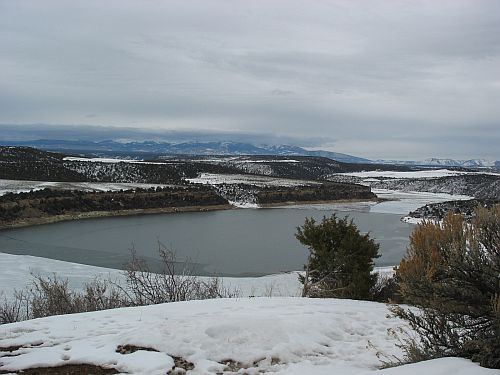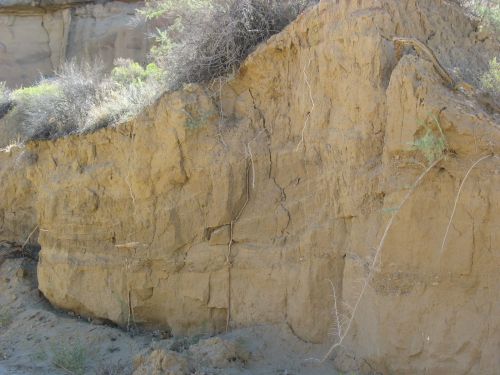As I’ve discussed before, the patterns of use and importation of chipped stone at Chaco are somewhat puzzling. Unlike many other commodities, such as wood, corn, and pottery, which were imported from specific distant locations within the Chacoan sphere of influence in astonishing quantities during the height of Chaco’s regional power, chipped stone seems to have been largely a mundane, utilitarian concern. Throughout all periods of Chaco’s occupation most chipped stone was local. At Chaco’s peak of power and influence between AD 1020 and 1130 there was a slight uptick in imports of stone, particularly a distinctive pink chert from the Narbona Pass area to the west.
As I noted in the earlier post, however, obsidian follows a different pattern from the other imported stones. It is most common not at the height of Chaco’s regional power in the eleventh century but much earlier, in the Basketmaker III period between AD 500 and 750, when it is the most common nonlocal type of chipped stone. This was a time when Chaco may have seen an earlier period of regional importance, although figuring out what was going on at this time is very difficult for several reasons. By the Pueblo I period the amount of obsidian seems to drop precipitously, and it doesn’t start to recover until the very end of Chaco’s period of Pueblo occupation after AD 1120. This pattern puts obsidian decidedly out of phase with most other material culture imports to the canyon, which tend to correlate with the well-known evidence for social complexity and monumental architecture that we associate with the Chaco Phenomenon.
A recent paper by Andrew Duff, Jeremy Moss, Tom Windes, John Kantner, and Steven Shackley tries to put the obsidian evidence on a firmer footing by using geochemical sourcing to identify the source outcrops for a broad sample of obsidian found at Chaco and at various Chacoan outlier communities in the San Juan Basin. As they note, this is the latest chapter in a complicated story. Way back in the 1980s, the Chaco Project did an extensive sourcing study of obsidian found in its excavations in the canyon using X-ray fluorescence (XRF), a non-destructive sourcing technique that was then relatively new in archaeology. Their results, reported by Cathy Cameron in a number of publications, were surprising. They seemed to show that the closest source of obsidian, Mt. Taylor, provided very little of the obsidian found at Chaco (about 4%), while a distant source, Red Hill in Catron County, New Mexico, provided a very high proportion, especially in the assemblages from earlier sites. Also well-represented was obsidian from the Jemez Mountains, the second-closest source, with the proportion of Jemez obsidian increasing over time, a common pattern in the northern Southwest.
This seemed to indicate that there were substantial early ties between Chaco and the Red Hill area, far to the south but still just barely adjacent to some known Chacoan outliers. This result was mentioned in many publications on Chaco over the years, although many people didn’t really seem to know what to think of it. However, it soon began to be questioned. After this initial sourcing study had been done, Tom Windes submitted some samples of obsidian from Pueblo Alto and the Spadefoot Toad site for obsidian hydration dating, which involved a sourcing analysis as an intermediate step in the dating process. These analyses were inconclusive when it came to dating the artifacts (not uncommon in the Southwest, where obsidian hydration has a poor record as a dating technique), but the sourcing portion suggested strongly that the samples that had previously been sourced to Red Hill instead came from Mt. Taylor. Windes mentioned this anomaly in his site reports, as did Cameron in her subsequent publications on the subject, but a full published account didn’t appear until this new study.
The new study also used XRF to do the sourcing analysis, but both analytical techniques and source characterizations have improved considerably since the 1980s, so the results were quite different from the first effort. For some reason this study was unable to do a complete reanalysis of the earlier samples (although it implies that this may be possible in the future), so there was only limited overlap and the focus was mostly on recent samples collected by Windes at Basketmaker III and Pueblo I site in and around Chaco, as well as outlier sites studied by Kantner in the Red Mesa Valley near Mt. Taylor and by Duff at the southern edge of the Colorado Plateau near Red Hill.
The results were not really surprising, in that they have been known in broad outline since Windes submitted his samples for dating and reported on the sourcing anomalies, but it’s nice to see them formalized in a peer-reviewed paper. Basically, this study found that no samples from Chaco came from Red Hill, although a few came from other sources in the same general area, and that the most common source found at Chaco was Mt. Taylor. Over time there was a trend in the Chaco data showing a shift from Mt. Taylor to Jemez sources, accompanied by the well-known trend toward less obsidian in assemblages overall. The sample from the Blue J site near Mt. Taylor, in contrast, showed high proportions of Mt. Taylor obsidian increasing over time, in marked contrast to the Chaco pattern. The southern sites showed assemblages of obsidian almost entirely composed of Red Hill and other nearby sources.
Basically, the overall pattern was a classic distance-decay distribution, where the prevalence of a given source at a given site was mostly predictable by the distance between the source and the site. This is in sharp contrast to the pattern for many other imported goods at Chaco, which are present in high quantities in the source areas and at Chaco but not in between. This suggests strongly that obsidian was not part of any general Chacoan exchange system(s) but was procured by individual communities in accordance with their own needs, mostly using the closest sources. This is in keeping with the general tendency for chipped stone to be a relatively low-priority commodity in these societies.
The paper mentions the decline in overall abundance of obsidian after the Basketmaker III period at Chaco, but doesn’t spend much time discussing it beyond saying this:
The overall decrease in obsidian use noted at Chaco sites may reflect a shift in technological focus away from hunting and a subsequent focus on grinding technology as agriculture becomes the dominant subsistence strategy.
As I’ve noted before, this is almost certainly wrong; the decrease in question occurs at the end of the Basketmaker III period, at which time there is considerable evidence that Southwestern populations were already heavily dependent on agriculture. The decrease in obsidian is still odd, though. One thought I’ve had to explain it is that maybe the obsidian from after this period isn’t actually missing at all, but is at Pueblo Bonito, which had lots of obsidian but was excavated a long time ago using techniques that aren’t really comparable to the modern techniques used by the Chaco Project and later efforts that resulted in the collections being analyzed here. I would suggest that an XRF sourcing analysis of the Bonito obsidian would be interesting. As it is, there’s a huge shift in the proportions of the different sources at Chaco between Basketmaker III and Pueblo I. The earlier samples (dominated by the huge samples from the major villages of Shabik’eschee and 29SJ423) show a predominance of Mt. Taylor obsidian, while the later ones show mostly Jemez sources. The sample size is so much smaller for the later period, however, that I’m skeptical about taking this flip at face value. Including the Bonito assemblage might help to bridge this gap, or at least explain it.
Finally, it’s again noteworthy how unimportant obsidian appears to have been to the Chaco system. Even if the Pueblo Bonito evidence ends up indicating a more important role at Chaco itself, the various outlier communities appear to have used local sources and to have followed their own priorities in acquiring this commodity rather than getting it through any Chaco-controlled or -oriented system. This is one of the ways that Chaco appears to diverge from Mesoamerican societies, despite recent evidence that it may have had more contact with them than was previously believed. Obsidian was hugely important symbolically in Mexico, and control of major sources was a major source of power and wealth for various Mesoamerican polities. In the Southwest, however, nobody seems to have cared that much about controlling major obsidian sources, and obsidian seems to have been distributed as a fairly ordinary commodity without any particular symbolic importance. I think this is one of the strongest pieces of evidence suggesting that whatever influence Mesoamerican societies may have had on Chaco was indirect and mediated by Chacoan elites rather than imposed directly from Mexico, as some have argued.
In any case, while this isn’t really the most exciting paper, it’s still an important one in straightening out a part of Chacoan archaeology that had become pretty confused. Obsidian may not have been all that important at Chaco, but it’s still worth studying in part precisely because of its mundanity.
![]()
Duff, Andrew I., Moss, Jeremy M., Windes, Thomas C., Kantner, John, & Shackley, M. Steven (2012). Patterning in procurement of obsidian in Chaco Canyon and in Chaco-era communities in New Mexico as revealed by X-ray fluorescence Journal of Archaeological Science, 39 (9), 2995-3007 DOI: 10.1016/j.jas.2012.04.032




















